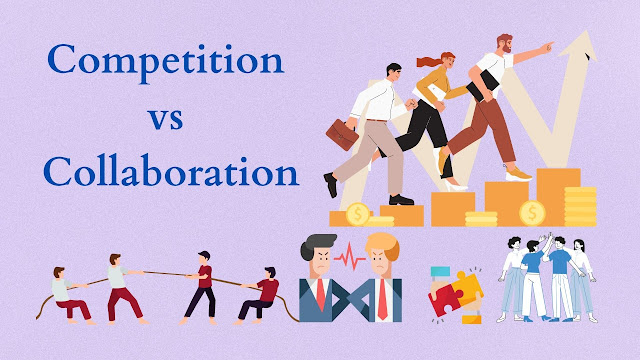In the intricate tapestry of the professional realm, the delicate balance between competition and collaboration defines the heartbeat of an organization. Recently, Bartleby's insightful column in The Economist added a new layer to this ongoing conversation, prompting a deeper contemplation of the dynamics at play. As we embark on a journey to explore the nuanced interplay between individual prowess and collective synergy, let's delve into the complexities and discover the art of harmonizing competition and collaboration in the modern workplace.
Competition vs Colloboration
Competition:
- Drives individual performance.
- Can foster innovation and creativity.
- May lead to a results-oriented culture.
- Encourages accountability.
Collaboration:
- Promotes teamwork and shared goals.
- Enhances communication and knowledge sharing.
- Builds a positive workplace culture.
- Fosters a sense of belonging and camaraderie.
++++
Balancing" competition and collaboration" in the organizational environment:
Clear Objectives:
- Define clear goals for both individual and team achievements.
- Align these objectives with the overall organizational strategy.
Communication:
- Foster open communication channels to share ideas and challenges.
- Encourage feedback to enhance collaboration.
Team Building:
- Invest in team-building activities to strengthen collaboration.
- Recognize and reward both individual and collective achievements.
Leadership Role:
- Leadership should emphasize the importance of both competition and collaboration.
- Provide guidance on when to compete and when to collaborate.
Flexible Structures:
- Create a flexible organizational structure that allows for adaptation.
- Balance autonomy with teamwork as per project requirements.
Training and Development:
- Provide training on collaboration skills and effective competition strategies.
- Foster a culture of continuous learning.
Performance Metrics:
- Develop balanced performance metrics that consider both individual and team contributions.
- Avoid fostering a cutthroat competitive environment.
Cross-functional Projects:
- Encourage cross-functional projects to enhance collaboration across departments.
- Showcase successful collaborations as examples.
- Remember, these points are broad, and the implementation may vary based on the organization's specific context and goals.
- ++++++++
How managers can strike a balance between competition and collaboration within their teams:?
Clear Expectations:
- Set clear expectations for individual and team performance.
- Clarify when healthy competition is encouraged and when collaboration is essential.
Regular Communication:
- Foster open and regular communication within the team.
- Discuss the importance of collaboration in achieving shared goals.
Recognition and Rewards:
- Recognize and reward both individual and team achievements.
- Emphasize the value of collective success.
Team-building Activities:
- Organize team-building activities to strengthen relationships.
- Encourage social interactions to build camaraderie.
Leadership Example:
- Lead by example by demonstrating a balance between competition and collaboration.
- Showcase situations where collaboration led to success.
Feedback Mechanism:
- Establish a feedback mechanism to address concerns and improve collaboration.
- Encourage team members to provide constructive feedback.
Skill Development:
- Invest in training programs to develop collaboration skills.
- Provide resources for team members to enhance their individual competencies.
Project Planning:
- Integrate both competitive and collaborative elements into project planning.
- Clearly define roles and responsibilities to avoid conflicts.
Flexibility in Approach:
- Be flexible in adapting the approach based on the nature of tasks and projects.
- Recognize that different situations may require different approaches.
Conflict Resolution:
- Develop effective conflict resolution mechanisms.
- Address conflicts promptly to maintain a healthy team dynamic.
Remember, it's essential to tailor these strategies to the specific dynamics and needs of your team.
++++++
Here are a few additional points on competition vs collaboration:
Cultural Impact:
- Explore how organizational culture influences the balance between competition and collaboration.
- Discuss the role of cultural diversity in shaping these dynamics.
- Example: In a multinational corporation, a competitive culture may thrive in sales teams, driving individuals to surpass targets. Simultaneously, collaborative cultures in research and development teams encourage knowledge sharing for breakthrough innovations.
Innovation and Creativity:
- Examine how competition and collaboration contribute to innovation.
- Highlight examples where healthy competition sparked creative solutions and where collaboration led to groundbreaking ideas.
- Example: A tech company may host hackathons (competition) to foster innovation, while cross-functional workshops (collaboration) bring together diverse perspectives to brainstorm and create novel solutions.
Adaptability in Leadership:
- Discuss the role of leadership in adapting to different situations.
- Explore how leaders can gauge when to foster competition for efficiency and when to encourage collaboration for holistic growth.
- Example: A startup's leader might encourage friendly internal competitions to meet tight deadlines, yet in strategic planning, the same leader promotes collaborative sessions to ensure all voices are heard for informed decision-making.
Technology's Influence:
- Analyze how technology has impacted the way teams compete and collaborate.
- Explore the role of virtual collaboration tools and platforms in the modern workplace.
- Example: Virtual collaboration tools like Slack and Zoom enable seamless communication across remote teams (collaboration), while project management software may introduce performance metrics to foster healthy competition among teams.
Psychological Impact:
- Delve into the psychological aspects of competition and collaboration on employee motivation and well-being.
- Discuss how a balanced approach can contribute to a positive work environment.
- Example: An organization implementing a results-driven bonus system (competition) also invests in team-building retreats and mentorship programs (collaboration) to ensure employee well-being and satisfaction.
- Conclusion:-
In the ever-evolving landscape of the workplace, the dance between competition and collaboration orchestrates the rhythm of success. As we navigate the intricate steps of this dance, let us not forget that it's not a matter of choosing one over the other but crafting a harmonious symphony where both elements coalesce. Perhaps, in this delicate equilibrium, we find the true essence of organizational prowess. As we conclude our exploration, may your workplace, like a well-choreographed performance, seamlessly blend the strengths of competition and collaboration to create a masterpiece of achievements.
Keep striving, keep collaborating, and until our next reflection,
Cheers, Karthik 28/1/24.










